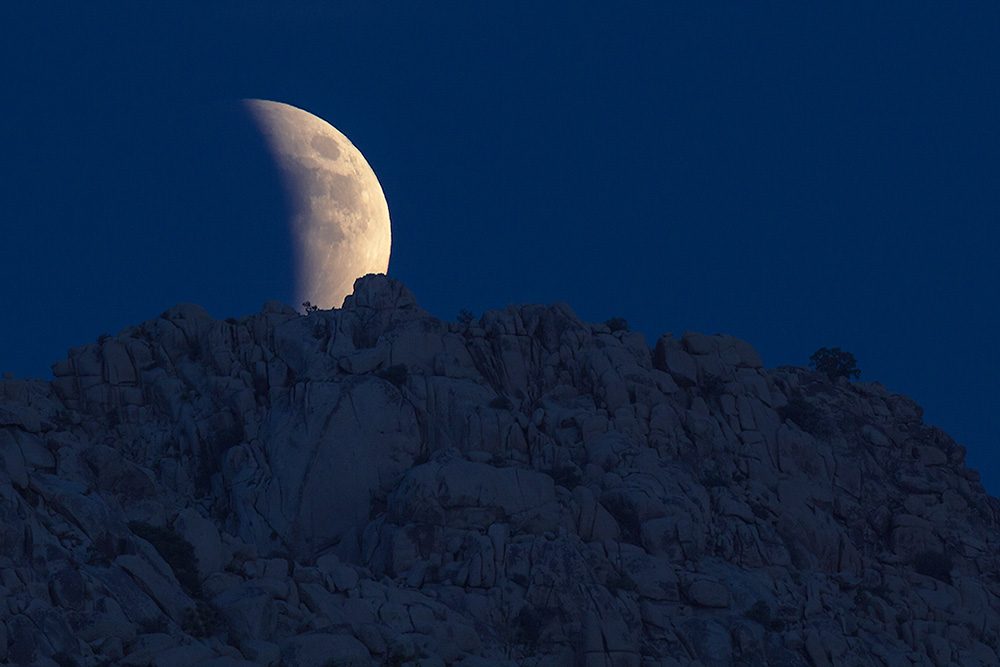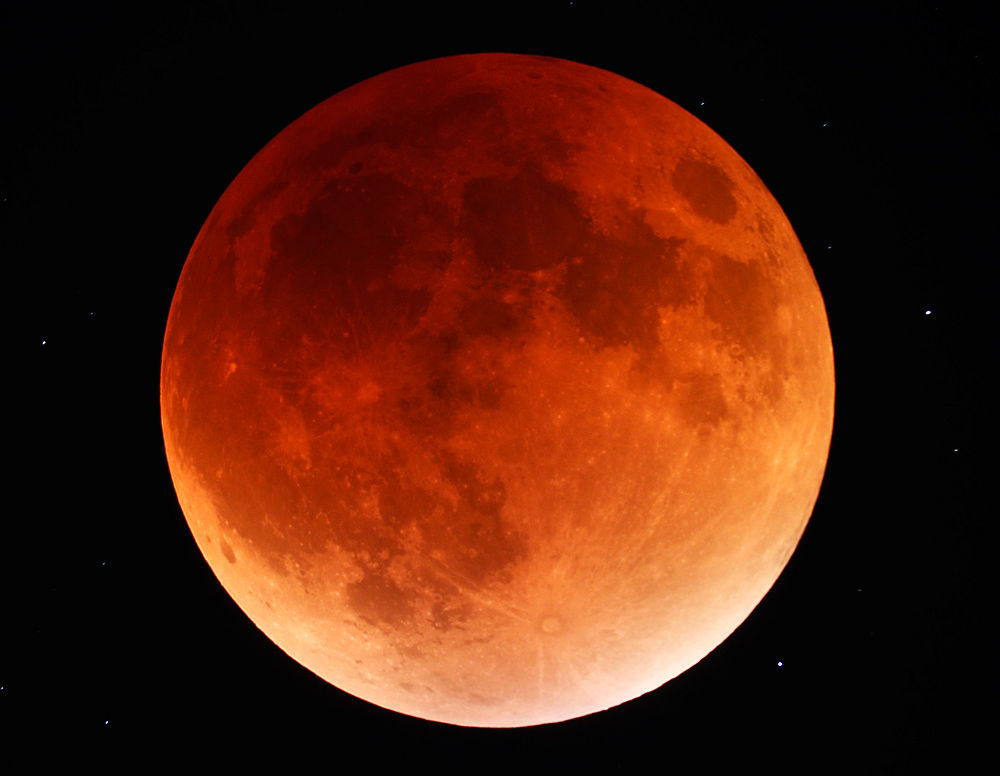A Look Back at the Total Lunar Eclipse




Call it a blood Moon, supermoon, harvest Moon, a portent of the apocalypse, or just a regular ol' total lunar eclipse — for those who caught a glimpse, last night's celestial event did not disappoint.

Equipment Editor Sean Walker assembled this eclipse montage, collected using an 8-inch Newtonian at f/3.3 (provided by Dennis di Cicco) and Canon D1000 camera.
Sky & Telescope editors had been looking forward to last night's total lunar eclipse for a multitude reasons. For starters, there's something incredible about eclipses of any kind — they have a way of altering our perspective, changing the way we experience and relate to the Sun and Moon. And last night's total lunar eclipse was the last one that we'll see until January 2018, plenty of motivation to enjoy the event to the fullest.
Last but not least, we also planned a live webcast of the event, complete with a full line-up of experts. Unfortunately, the incredible amount of traffic drove Livestream to its knees (not just for our feed, but for those of Griffith Observatory, NASA, and Slooh as well). So while many were able to watch the webcast live, not everybody who wanted to was able to tune in. If you missed it last night, it's well worth listening in today — the stories and science will give you a new perspective on the Moon, eclipsed or no. Here's the line-up:
- Alan MacRobert (starts at 4:00)
- Maria Zuber (starts at 22:00)
- Andrew Chaikin (starts at 49:00)
- Charles Wood (starts at 1:16:45)
- Erich Karkoschka (starts at 1:33:50)

Our editor's pick of online photo gallery submissions, this photo shows the partially eclipsed Moon rising above Joshua Tree, California.
Pauline Acalin / Online Photo Gallery
Pauline Acalin / Online Photo Gallery
S&T Senior Editor Kelly Beatty shares his decidedly digital experience of viewing the lunar eclipse:
When Sky & Telescope's editors decided to webcast September 27th's total lunar eclipse, we suspected it would be popular. After all, it was the last of four consecutive total lunar eclipses in a row; it occurred almost exactly when the Moon was closest to Earth for all of 2015; and it would be last total lunar eclipse visible anywhere until January 31, 2018.Our "nerve center" was the main studio of Chelmsford TeleMedia, a local public-access facility in my hometown. Thanks to the Herculean efforts of producer Dan Silvia (with assists from Dan's dad, Carl, and CTM engineer Tom Peterson), it all came together seamlessly. They streamed our high-definition video feed directly to Livestream.com.The webcast featured continuous coverage of the eclipsed Moon and provided audio-only interviews with lunar experts to describe the event and to discuss current lunar research. Guests familiar to S&T readers — Alan MacRobert, Sean Walker, Chuck Wood, and Andy Chaikin — were joined by scientists Maria Zuber (MIT) and Erich Karkoschka (University of Arizona). Telescopic Moon views came courtesy of volunteers Bruce Berger, George Pacquin, and Joe Wolfe of the Amateur Telescope Makers of Boston.Even the weather cooperated! A big storm system off the Carolina coast threatened to move northward, spoiling our view from the Boston area. But it weakened just in time, and we enjoyed a clear, "picture-perfect" night sky. Moonrise was spectacular, a positive harbinger for the night ahead.As sometimes happens, I found myself stuck inside the studio coordinating the interviews, so only occasionally did I get to pop outside for a quick look at the celestial goings-on overhead. But I could tell that totality was rather dark — more so than I expected.Ours wasn't the only eclipse webcast last night, but it proved wildly popular. At last check, our lunar-eclipse webcast had been visited 1.5 million times. In fact, long after the eclipse ended thousands of viewers were still coming to the page to see what the eclipse was all about. It's great that we were able to show them this special celestial event!

An 8-second exposure on a 1000-mm f/5 GSO Newtonian reflector revealed the eclipsed Moon above the western horizon in Brielow near Brandenburg an der Havel, Germany.
Christoff Rollwagen
Christoff Rollwagen
A total lunar eclipse is also a perfect opportunity for public outreach because the eclipse is visible without any optical aid — so if you're waiting for a view through the telescope, binoculars and naked-eye views will do. From Monica Young, S&T's web editor:
Before I took an invitation to visit the Harvard College Observatory for the lunar eclipse, I'd already been hearing plenty about the “Super-Harvest-Apocalypse-Blood Moon!” So it didn't surprise me when I arrived to see a record-breaking turnout. The observatory filled up long before I got there, and the line to get in kept growing until it snaked all the way through the long parking lot and down to the street. I waited an hour just to get inside and another hour to get a fabulous view of the Moon’s illuminated limb through the 9-inch Clark refractor.But waiting is fun when you have good company and a pair of 10×50 binoculars to pass around. (I was happy to share the view, especially with a woman who had brought her birding binoculars — as she said, those were better for spotting blue jays on the Moon than the Moon itself!) It never ceases to amaze me how the seemingly flat Moon pops into 3D when viewed through even low-power binoculars, revealing a surprising level of detail. As the evening wore on, I watched the subtle red glow emerge within Earth’s shadow until a dim and auburn totality arrived.
S&T Observing Editor JR reports on a solo observing trip turned public outreach:
I set up my 130-mm f/5 reflector in the parking lot next to an old mill pond in the western suburbs of Boston. Ordinarily, I have this observing site to myself, but last night, there was a lot of traffic (and a lot of Canada geese). Many families stopped by to watch the action, including one who threw the kids up on the roof of the SUV. I snagged everyone I could to look through the scope — it’s always fun to listen to the reaction when someone looks through it for the first time. The best magnification/field-of-view compromise was a 17-mm Plössl eyepiece. It gave a good look at the lunar surface but also let us pick up some of the field stars as the eclipse deepened. A fantastically deep red at totality — couldn’t have a better conclusion to the tetrad.I spent a lot of time distracted as I tried to live-tweet the experience, but luckily it was a slow show. I was also distracted by the darkening sky and couldn’t help but do some binocular observing while my neighbors were at the eyepiece. Arcturus put on a good late-evening show, Capella won the late-night star wars. The Andromeda Galaxy played hide and seek thanks to one narrow strip of cloud in the sky.The dew became too much of a challenge before midnight, so I packed in the scope and watched the back half of the eclipse with binoculars and the naked eye. My alarm was pain-inducing this morning at 5:30, but getting up early meant I had the full Moon in my rear-view mirror for the first half of my morning commute. Not bad.

Mike Borman captured the totally eclipsed Moon through a 15-minute gap in the clouds,.
Mike Borman / Online Photo Gallery
Mike Borman / Online Photo Gallery
John Bortle, a Sky & Telescope contributing editor, chimes in with a detailed account:
- See more at: http://www.skyandtelescope.com/astronomy-news/observing-news/a-look-back-at-the-lunar-eclipse/?et_mid=788245&rid=250958391#sthash.1fbFb2tm.dpufAlthough I've been viewing lunar eclipses since 1953–54, clouds have hampered or obscured the past few events for me. In contrast, most of last night's event occurred in a pristine sky here in Stormville, New York. During totality my NELM was about 6.0 and the Milky Way spanned more than 120° of sky. Not at all bad for a (by today's standards) semi-rural site only 75 miles north of New York City.Once past first umbral contact, the skies remained perfect and virtually cloud-free until 11:10 p.m. EDT and were then mainly hampered by quite thin clouds which intervened until I quit at 11:55. I judged this eclipse to be quite odd. It resembled one that I recall seeing quite some years ago that was also very bright on the shadow's outer edges but very dark toward the center. I must say that I was initially rather disappointed on easily seeing the eclipsed portion of the disk with 10×50 binoculars when the shadow had advanced only 20% of the way across the lunar disk (9:20 p.m. EDT). Not long after, I saw it with no optical aid. This led me to believe that this would be another bright eclipse like so many recent ones. I was wrong.I considered the leading 10 arcminutes nearest the shadow's edge to be light dirty-yellow in color and rather bright. Several times early and late in the eclipse, I suspected a vague blue color in the shadow's rim, but I was never certain of it. Deeper in the shadow, the color transitioned to a dull red to the unaided eye. As the eclipse progressed, the bright dirty-yellow outer portion narrowed and was pushed steadily closer and closer to the lunar southwest limb. It then slowly rotated clockwise around the limb through the southernmost area of the disk and around to the southeast limb late in totality.Around mid-eclipse the area encompassing the northern third of the lunar disk and involving Oceanus Procellarum became very dark, making the northern limb difficult to define with the naked eye shortly after mid-eclipse. During this time colors were muted visually and more nondescript, or brownish-gray, than anything (features show up in a vivid reddish color in my photos, though). I ranked the eclipse as one of the most drab that I recall seeing. Even with my 10-inch Dobsonian at 50×, the colors were quite muted. To me the second half of the eclipse was notably darker overall than the first half.Ultimately I had to rank the eclipse fractionally on the Danjon Scale, something never intended by Danjon I suppose. The outer portion of the shadow was classic L = 3, while the majority of other aspects and the eclipse's darkness put it squarely class L = 2. So, the final figure I settled on was an L = 2.3 for the event. On the Fisher Scale it was a class 1, since near mid-eclipse I had considerable difficulty making out any of the maria without optical aid. Around mid-eclipse I also judged the moon's integrated magnitude as –1.6 using reversed 10x50 binoculars with appropriate corrections applied. This is quite a contrast to the –3s and –4s of the last couple of eclipses I've viewed in recent years.
No comments:
Post a Comment